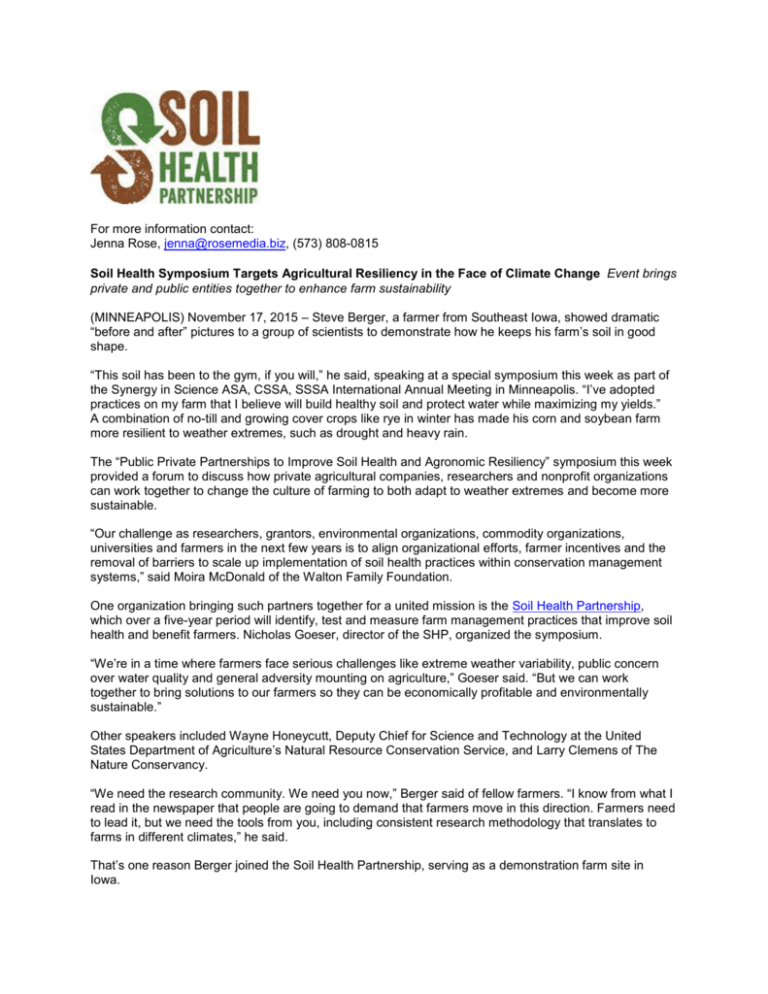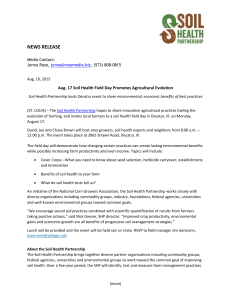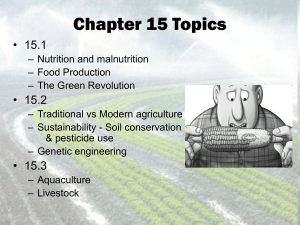11/17/2015: Soil Health Symposium Targets Agricultural Resiliency
advertisement

For more information contact: Jenna Rose, jenna@rosemedia.biz, (573) 808-0815 Soil Health Symposium Targets Agricultural Resiliency in the Face of Climate Change Event brings private and public entities together to enhance farm sustainability (MINNEAPOLIS) November 17, 2015 – Steve Berger, a farmer from Southeast Iowa, showed dramatic “before and after” pictures to a group of scientists to demonstrate how he keeps his farm’s soil in good shape. “This soil has been to the gym, if you will,” he said, speaking at a special symposium this week as part of the Synergy in Science ASA, CSSA, SSSA International Annual Meeting in Minneapolis. “I’ve adopted practices on my farm that I believe will build healthy soil and protect water while maximizing my yields.” A combination of no-till and growing cover crops like rye in winter has made his corn and soybean farm more resilient to weather extremes, such as drought and heavy rain. The “Public Private Partnerships to Improve Soil Health and Agronomic Resiliency” symposium this week provided a forum to discuss how private agricultural companies, researchers and nonprofit organizations can work together to change the culture of farming to both adapt to weather extremes and become more sustainable. “Our challenge as researchers, grantors, environmental organizations, commodity organizations, universities and farmers in the next few years is to align organizational efforts, farmer incentives and the removal of barriers to scale up implementation of soil health practices within conservation management systems,” said Moira McDonald of the Walton Family Foundation. One organization bringing such partners together for a united mission is the Soil Health Partnership, which over a five-year period will identify, test and measure farm management practices that improve soil health and benefit farmers. Nicholas Goeser, director of the SHP, organized the symposium. “We’re in a time where farmers face serious challenges like extreme weather variability, public concern over water quality and general adversity mounting on agriculture,” Goeser said. “But we can work together to bring solutions to our farmers so they can be economically profitable and environmentally sustainable.” Other speakers included Wayne Honeycutt, Deputy Chief for Science and Technology at the United States Department of Agriculture’s Natural Resource Conservation Service, and Larry Clemens of The Nature Conservancy. “We need the research community. We need you now,” Berger said of fellow farmers. “I know from what I read in the newspaper that people are going to demand that farmers move in this direction. Farmers need to lead it, but we need the tools from you, including consistent research methodology that translates to farms in different climates,” he said. That’s one reason Berger joined the Soil Health Partnership, serving as a demonstration farm site in Iowa. “Data is a powerful driver of change,” he said. The Synergy in Science meeting is sponsored jointly by the American Society of Agronomy, Crop Science Society of America, and the Soil Science Society of America. About the Soil Health Partnership The Soil Health Partnership brings together diverse partner organizations including commodity groups, federal agencies, universities and environmental groups to work toward the common goal of improving soil health. Over a five-year period, the SHP will identify, test and measure farm management practices that improve soil health and benefit farmers. We believe the results of this farmer-led project will provide a platform for sharing peer-to-peer information, and lend resources to benefit agricultural sustainability and profitability. An initiative of the National Corn Growers Association, we provide the spark for greater understanding and implementation of agricultural best practices to protect resources for future generations. Visit the website for more.






